Why you can trust Tom's Hardware
Test Notes
We ran an extra series of tests to reflect performance in workstation-class workloads. Some of these applications make an appearance in our standard test suite on the following page, but those test configurations and benchmarks are focused on a typical desktop-class environment. In contrast, these tests are configured to stress the systems with workstation-class workloads.
With the exception of the W-3175X system, we loaded down our test platforms with 64GB of DDR4 memory spread across four modules to accommodate the expanded memory capacity required for several of these workstation-focused tasks. Due to the W-3175X's six channel memory controller and our limited stock of high-capacity DIMMs, we used six 8GB DIMMs for a total capacity of 48GB. All systems were tested at the vendor-specified supported memory data transfer rates for their respective stock configurations, and DDR4-3600 for the overclocked settings.
We also conducted the tests on this page with a PCIe 4.0 Gigabyte Aorus SSD for all of the test systems, including the Intel platforms that are limited to PCIe 3.0 throughput. This will enable additional platform-level performance gains from the increased throughput of the faster interface supported by AMD's processors.
All Threadripper processors are tested in creator mode, meaning the full heft of their prodigious number of cores and threads are in action. Due to the limited time available during the NDA test period, we only tested current-gen processors in overclocked configurations.
Puget Systems Benchmarks
Puget Systems is a boutique vendor that caters to professional users with custom-designed systems targeted at specific workloads. The company has developed a series of acclaimed benchmarks for Adobe software, which you can find here. We use several of the benchmarks for our first round of workstation testing, followed by SPECworkstation 3 benchmarks.
Adobe After Effects CC Render Node Benchmark
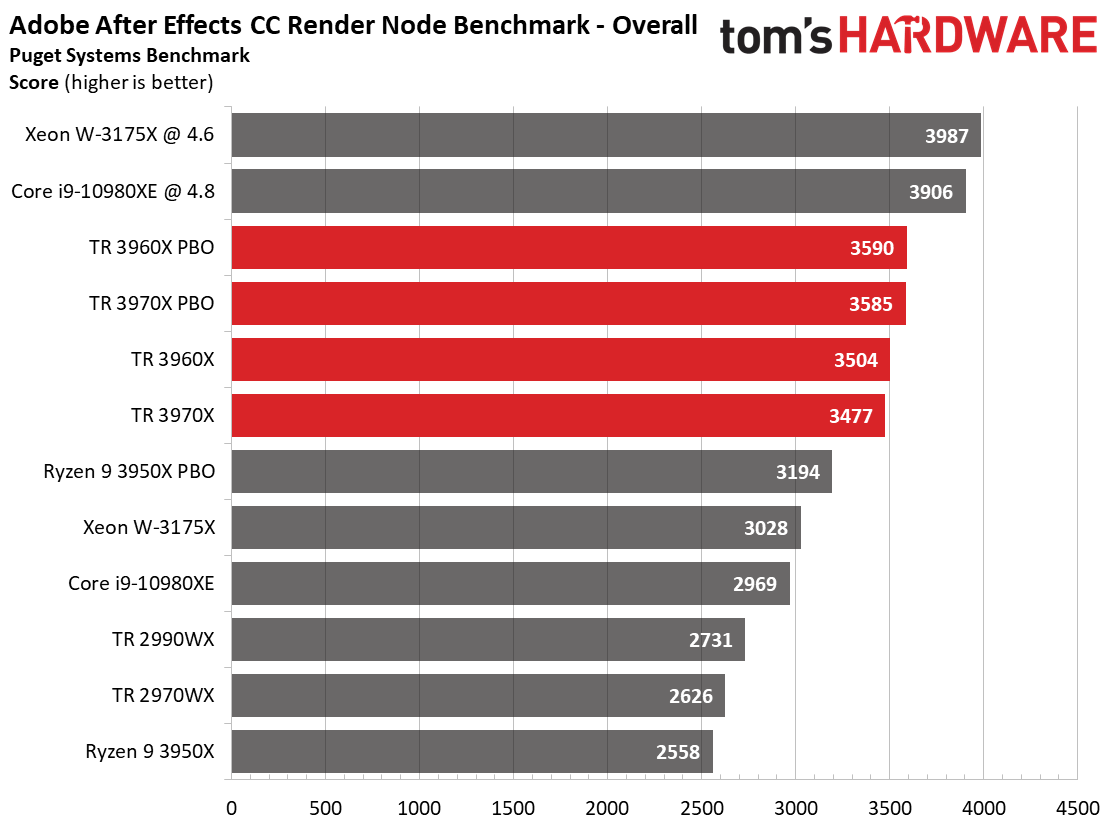
The After Effects render node benchmark leverages the in-built aerender application that splits the render engine across multiple threads to maximize CPU and GPU performance. This test is memory-intensive, so capacity and throughput are important and can be a limiting factor.
The Threadripper processors deliver outstanding performance in this test, which isn't surprising given their hefty core counts. Yet again, Intel's processors benefit handsomely from overclocking, but it's noteworthy that most professional users will not spend the time tuning the system to extract the extra performance. Instead, stability at stock settings is typically the most prized attribute.
Get Tom's Hardware's best news and in-depth reviews, straight to your inbox.
Adobe Premier Pro CC Benchmark
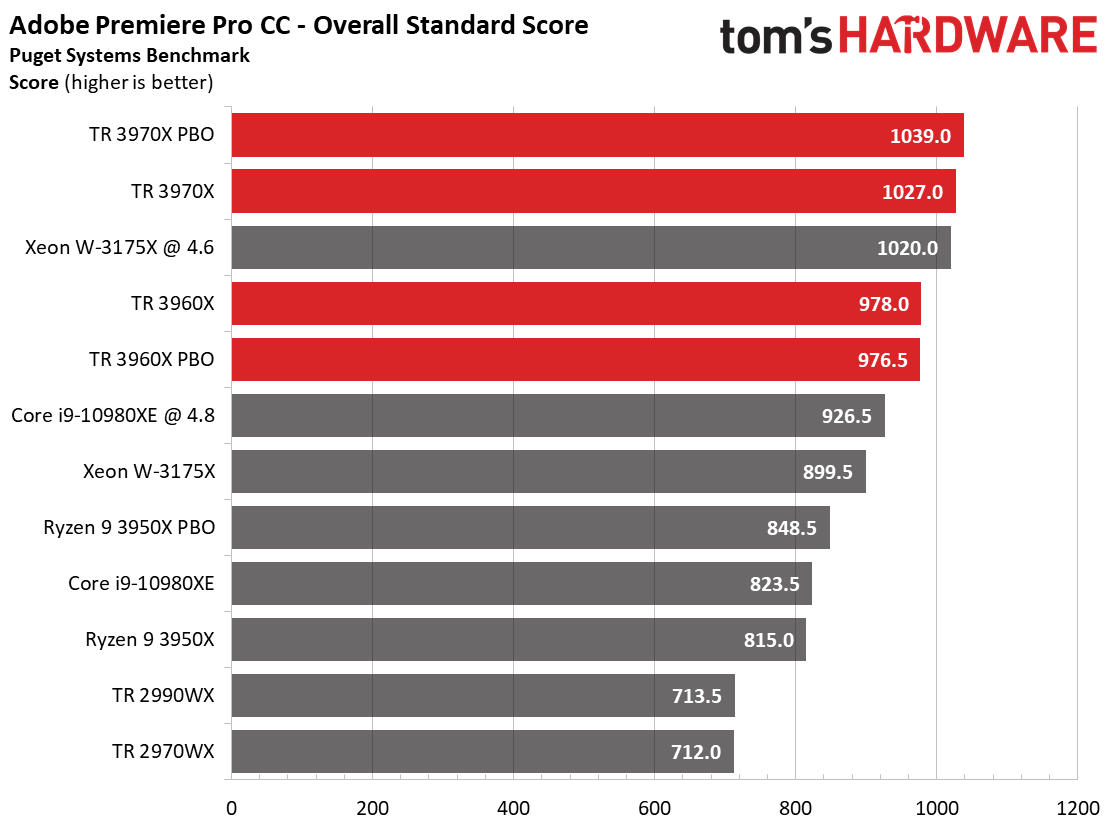
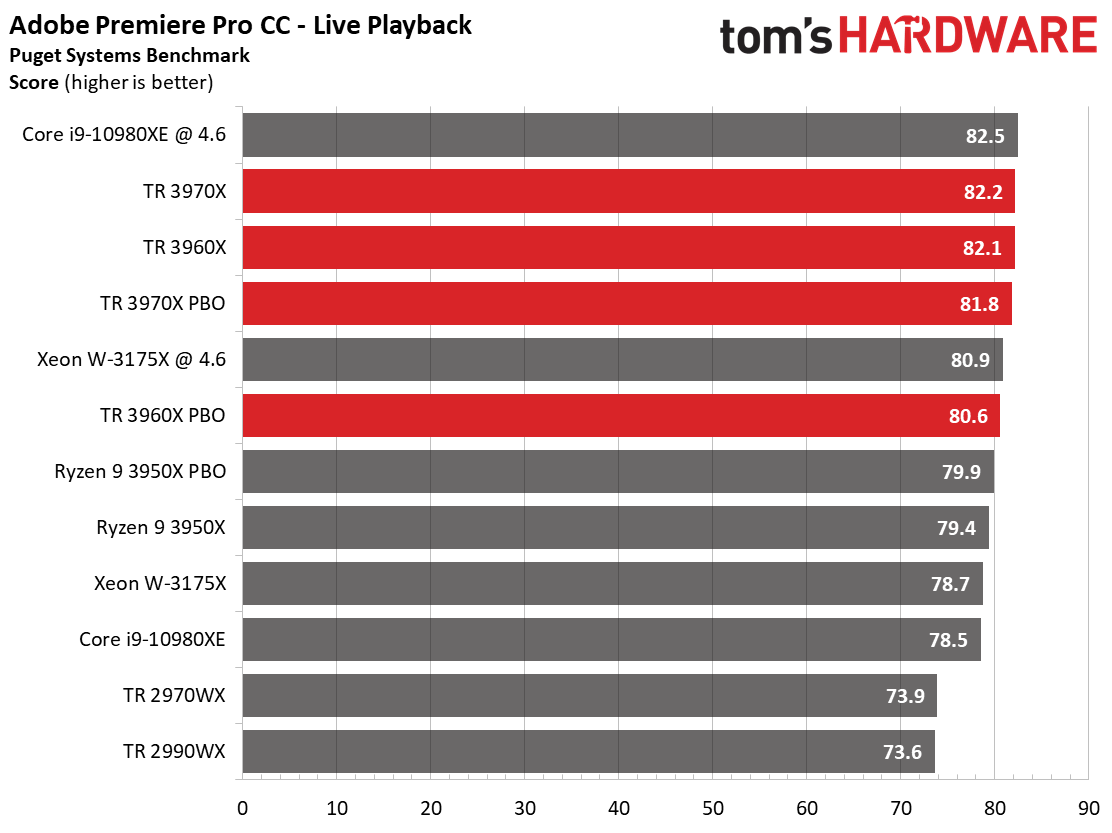
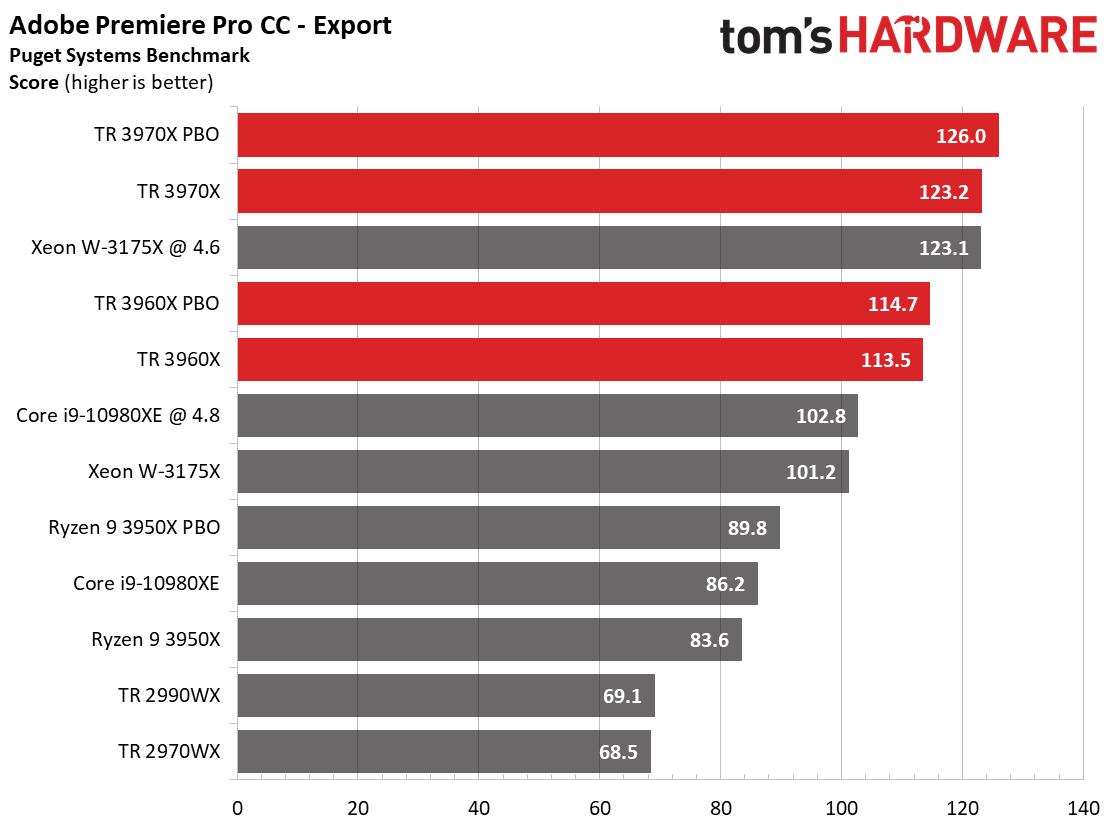
This benchmark measures live playback and export performance with several codecs at 4K and 8K resolutions. It also incorporates 'Heavy GPU' and 'Heavy CPU' effects that stress the system beyond a typical workload. Storage throughput also heavily impacts the score.
Feeding the Threadripper processors with the throughput of PCIe 4.0 certainly helps, but sheer brute computational force appears to be the name of the game: The overclocked Xeon W-3175X challenges the 3970X even though it only has access to the PCIe 3.0 interface. However, the Threadripper processors enjoy a comfortable lead at stock settings.
Aside from the second-gen Threadripper models, all of the chips sustain acceptable playback performance, but the real differentiation stems from the Export phase of the test.
Adobe Photoshop CC Benchmark
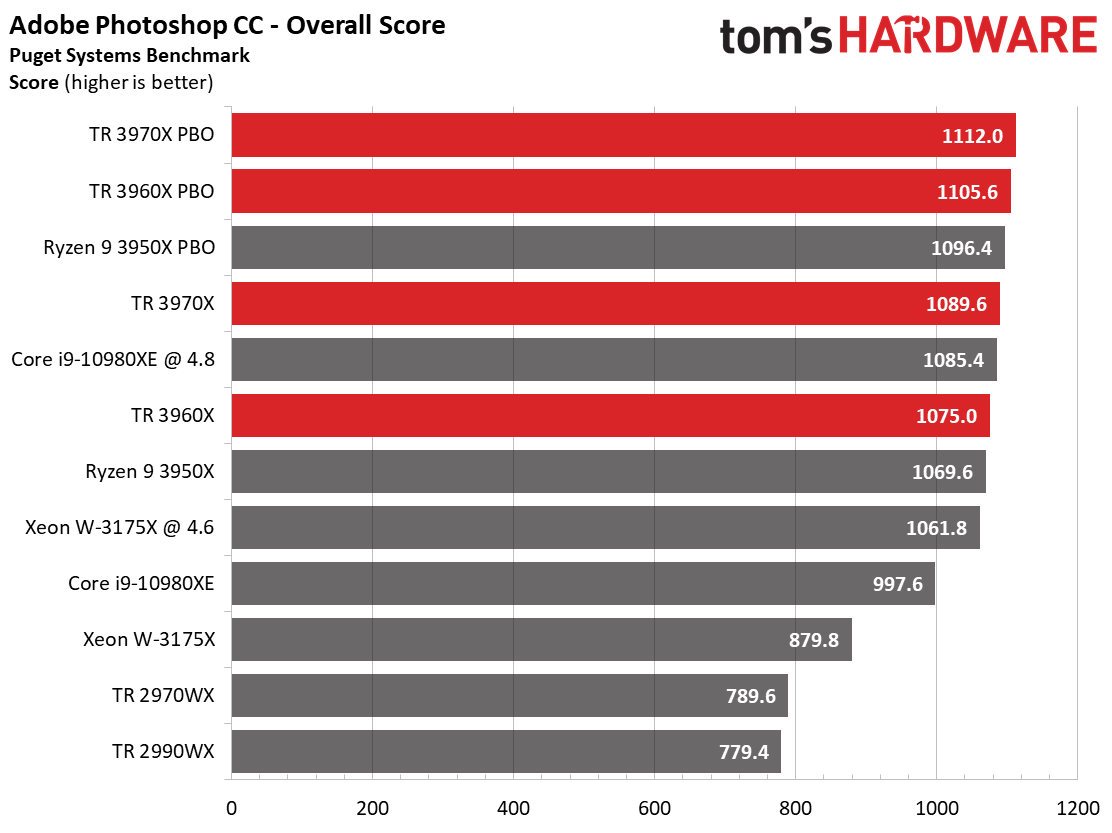
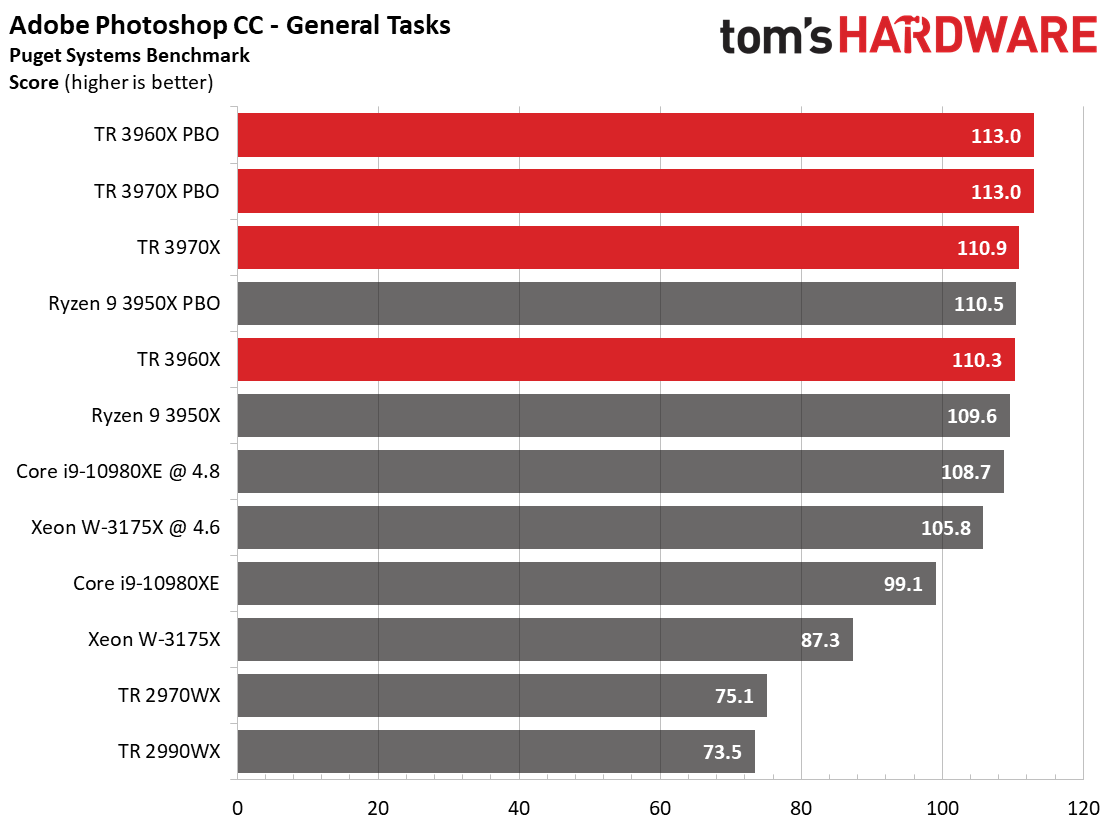


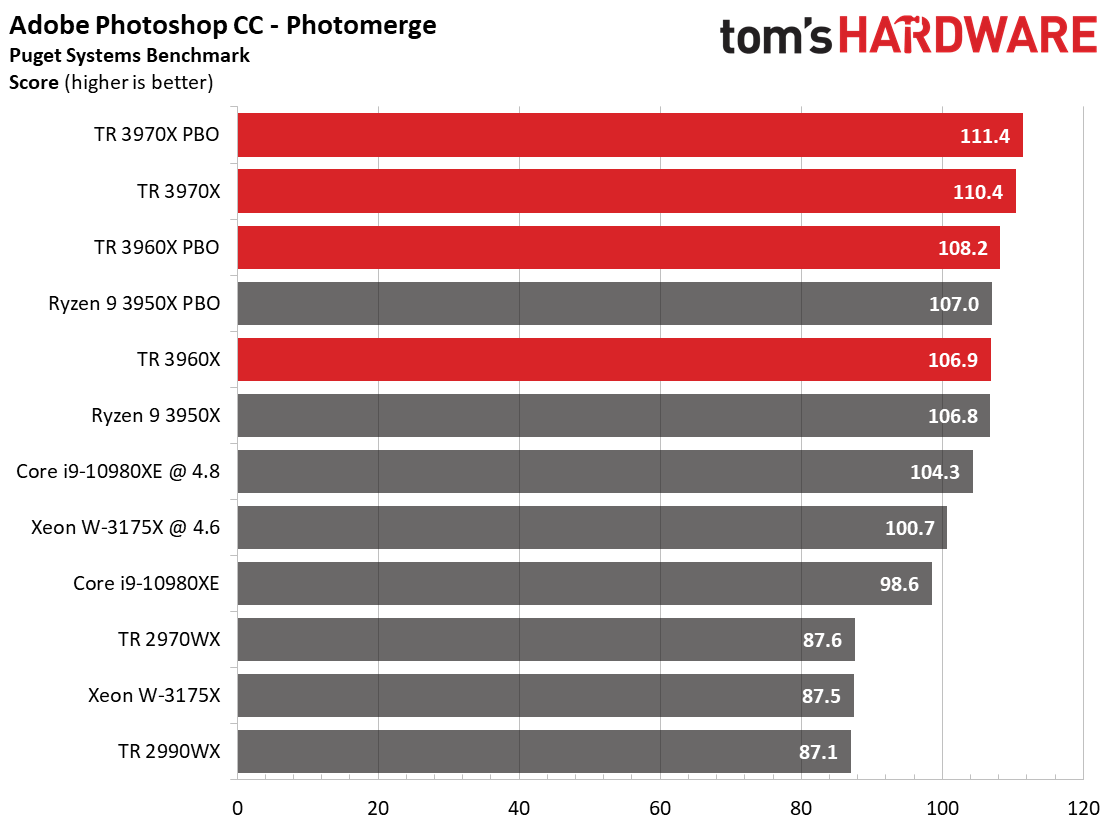
The Photoshop benchmark measures performance in a diverse range of tasks, measuring the amount of time taken to complete general tasks, create panoramas (photomerge results) and apply filters.
Once again the Threadripper processors prove their mettle with leading performance, but notice the Ryzen 9 3950X: That processor is significantly cheaper at $749 and drops into mainstream motherboards, which equates to lower overall platform pricing. It also only has access to a single dual-channel memory controller, yet manages to trade blows with Threadripper 3000's two dual-channel controllers. Given its pricing, and the performance you'll see throughout these workstation tests, the Ryzen 9 3950X steals the show.
SPECworkstation 3 Benchmarks
The SPECworkstation 3 benchmark suite is designed to measure workstation performance in professional applications. The full suite consists of more than 30 applications split among seven categories, but we've winnowed down the list to tests that largely focus specifically on CPU performance. We haven't submitted these benchmarks to the SPEC organization, so be aware these are not official benchmarks.
Media and Entertainment
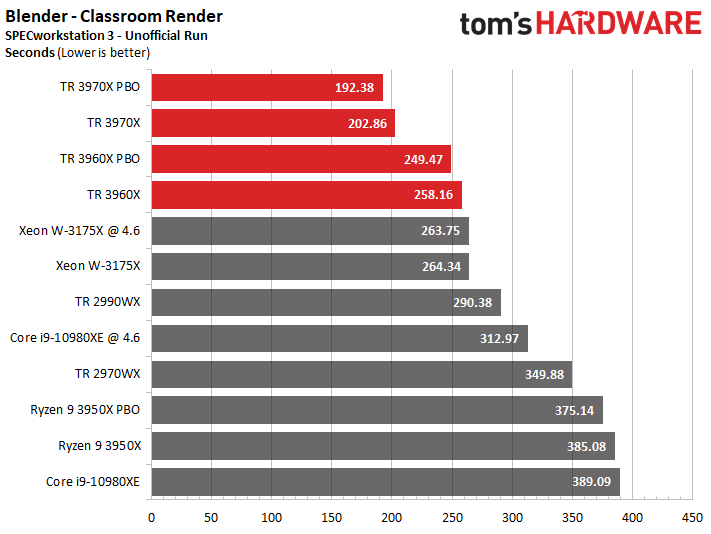
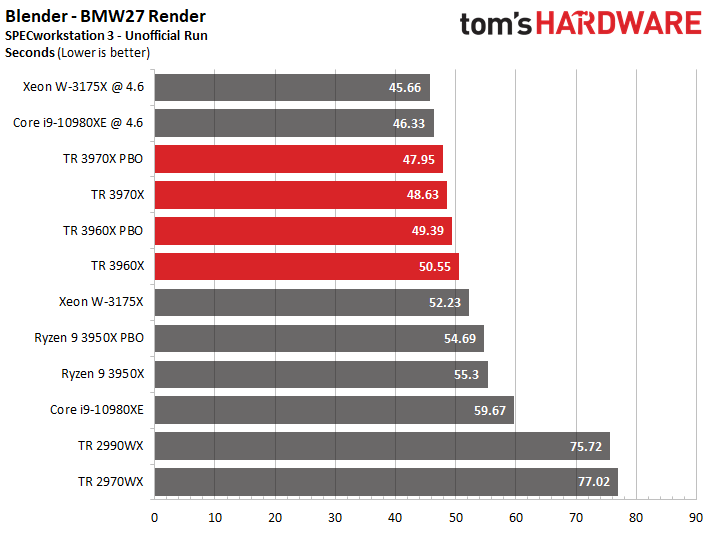
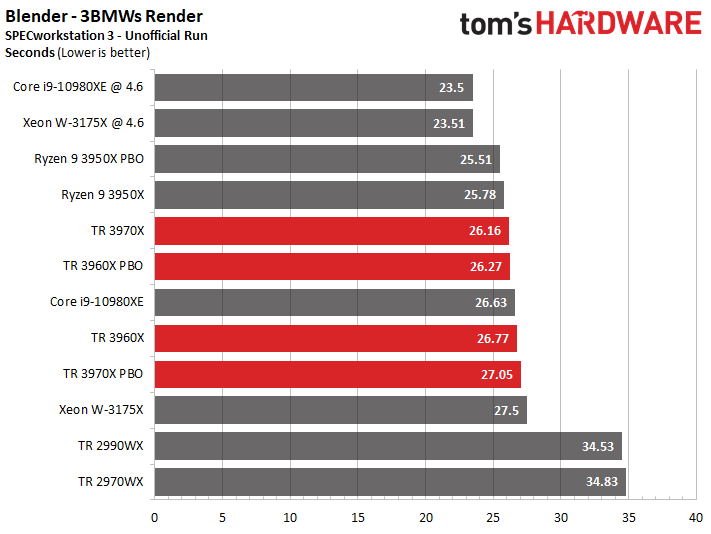
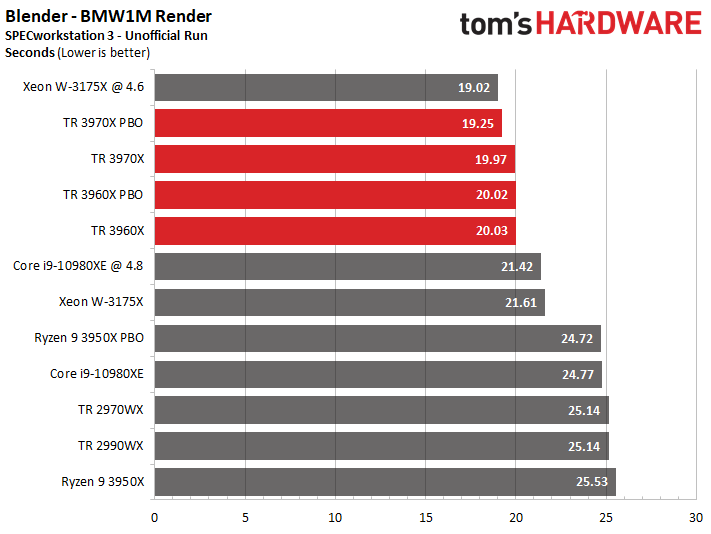
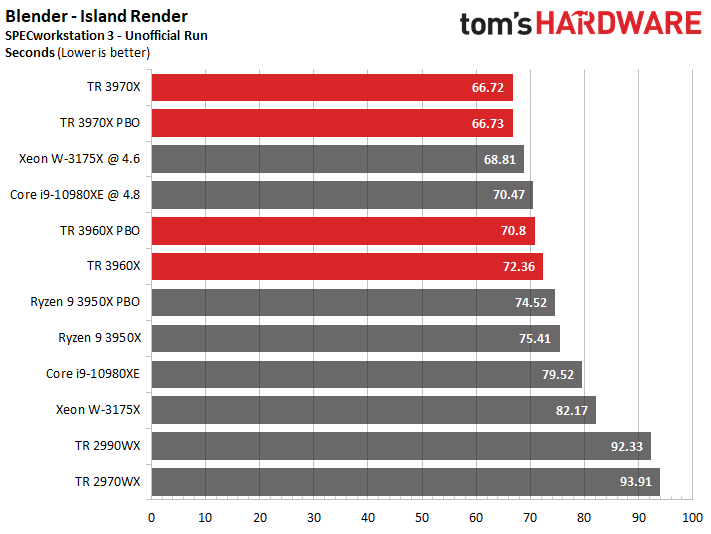
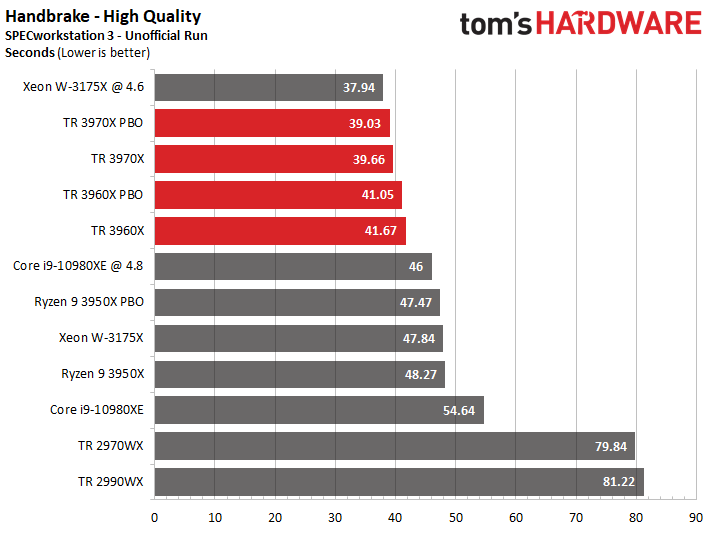
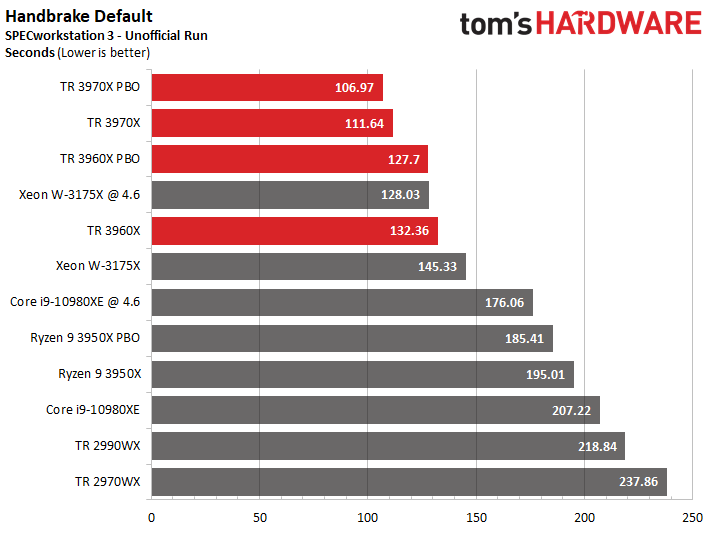
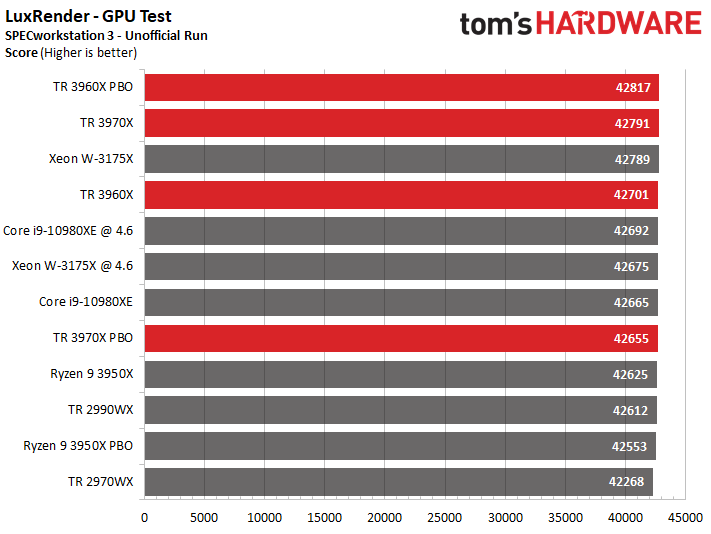
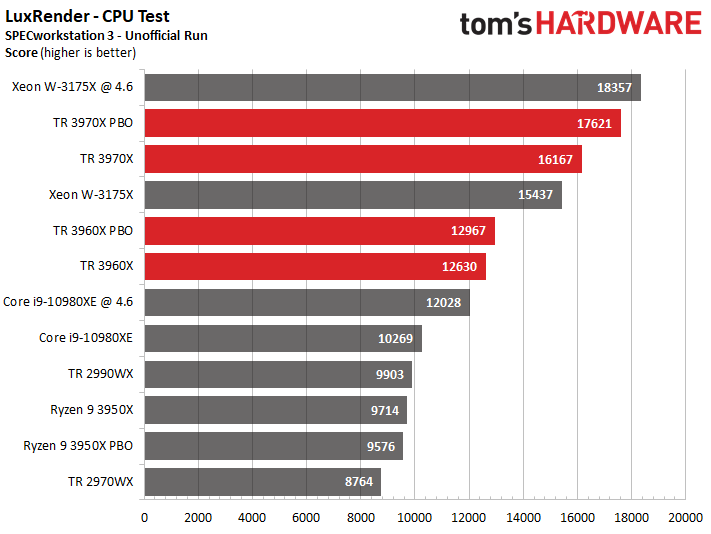
We run the new Blender Benchmark beta in our regular suite of tests on the following page, but different types of render jobs can stress processors in unique ways. Here we can see a breakout of several industry-standard benchmark renders that largely favor Threadripper 3000's architecture. Again, the Ryzen 9 3950X is incredibly potent in some of these workloads, but Threadripper dominates at stock settings, while Intel leverages its overclocking headroom to squeeze out some additional gains.
Threadripper steals the show in the Handbrake tests, too, and you'll notice a massive generational leap over the second-gen models. That is borne of AMD's revamped AVX engine.
In the LuxRender CPU tests, the Xeon W-3175X is competitive with the 3970X at stock settings, and takes the crown after overclocking. Meanwhile, the Core i9-9980XE challenges the 3960X, but it takes quite a bit of tuning to get there.
More workloads are leveraging the massive computational power of GPUs to accelerate key portions of parallelized workloads. The LuxRender GPU test shows us that all of the processors in our test pool offer similar performance with the task offloaded to the GPU (the slim variances in run-to-run performance are expected).
NAMD and Rodinia LifeSciences
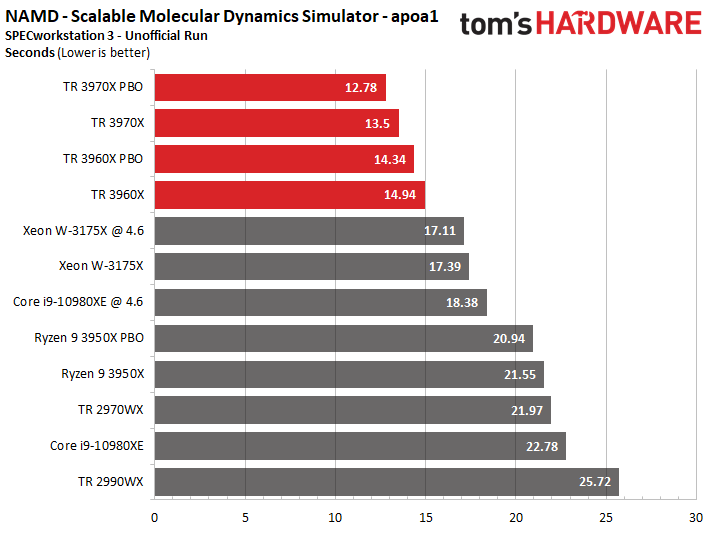
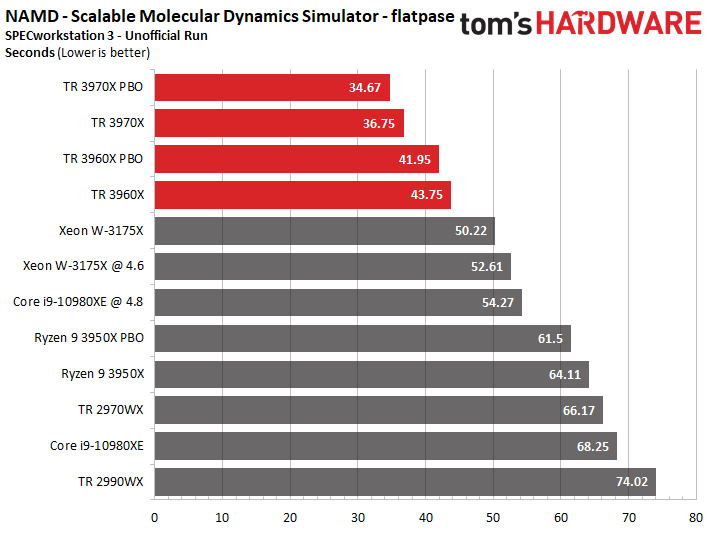
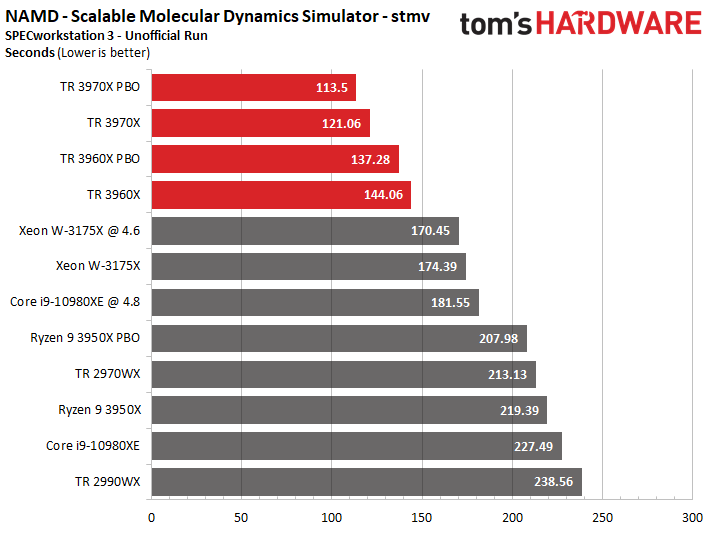
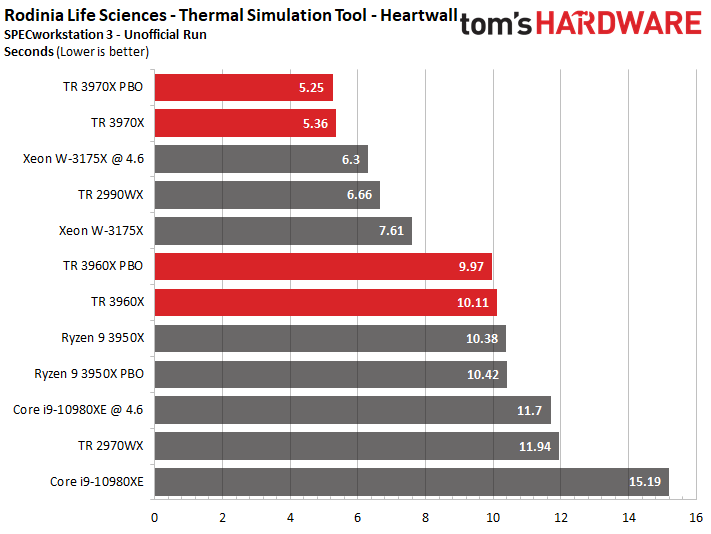
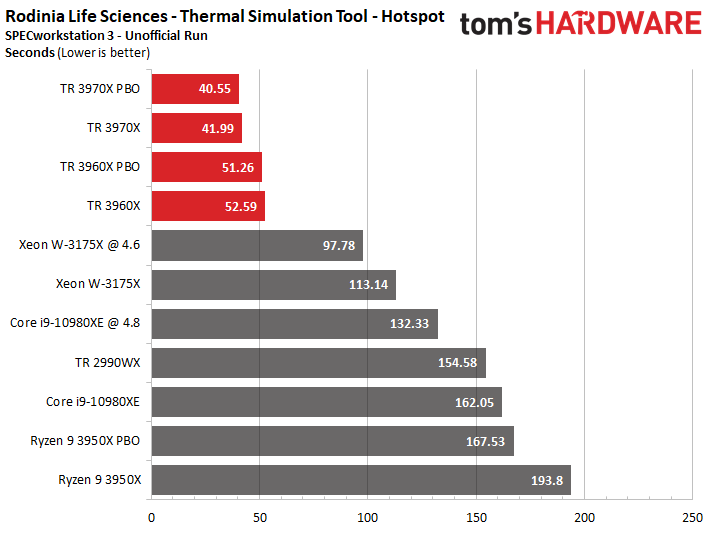
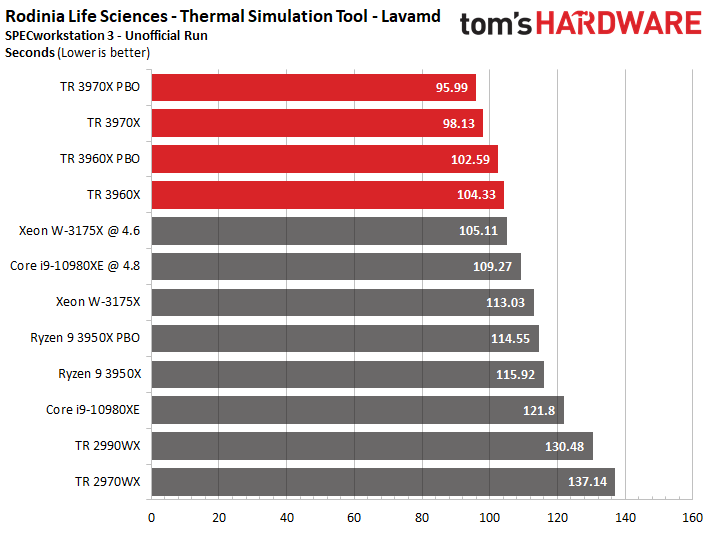
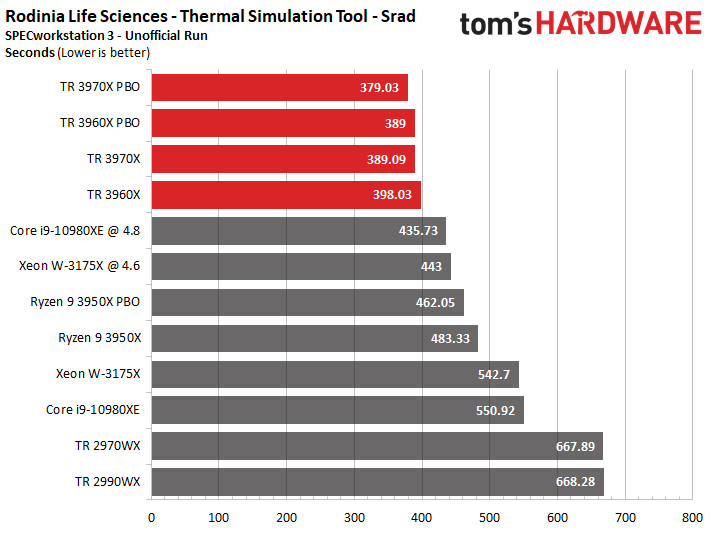
NAMD is a parallel molecular dynamics code designed to scale well with additional compute resources, and here we can see performance scale well across Threadripper's cores and threads through several permutations of the code.
SPECworkstation 3's Rodinia LifeSciences benchmark steps through four tests that include medical imaging, particle movements in a 3D space, a thermal simulation, and image-enhancing programs. The Hotspot thermal simulation stands out as another big step forward for AMD's Threadripper chips.
Product Development and Energy
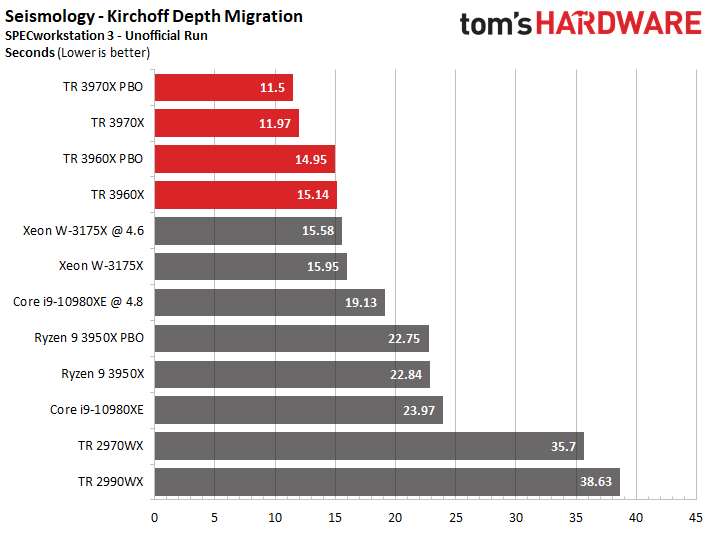
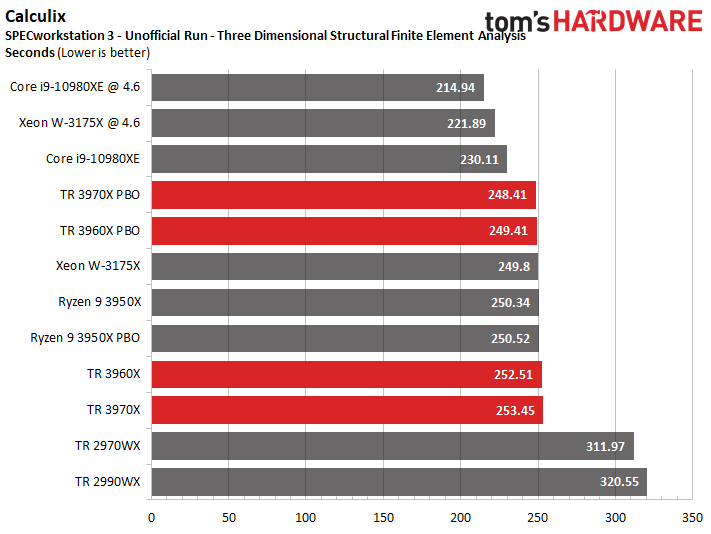
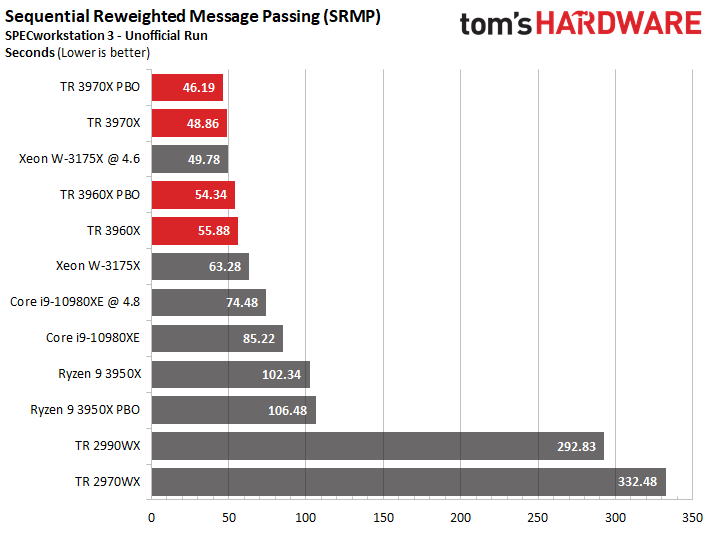
The earth’s subsurface structure can be determined via seismic processing. One of the four basic steps in this process is the Kirchhoff Migration, which is used to generate an image based on the available data using mathematical operations. Threadripper 3000 takes a pronounced win here, shedding some of the comparatively lackluster performance of the previous-gen models.
Calculix is based on the finite element method for three-dimensional structural computations. This benchmark performs well on the Intel processors, with the -10980XE being particularly impressive. Threadripper doesn't benefit much from tuning in this workload, but it is competitive. Again, the Ryzen 9 3950X pops into the conversation with surprisingly strong performance.
SRMP algorithms are used for discrete energy minimization. AMD processors have traditionally struggled with these tests, suggesting the benchmark might be latency-sensitive, but Threadripper 3000 reverses that trend in astonishing fashion. You'll notice the stock Ryzen 9 3950X is faster than its own overclocked configuration. We'll have to rerun that test to verify the metric, but this fast-running benchmark seems to have more variation than others, meaning this could be an outlier.
Financial and General Workloads
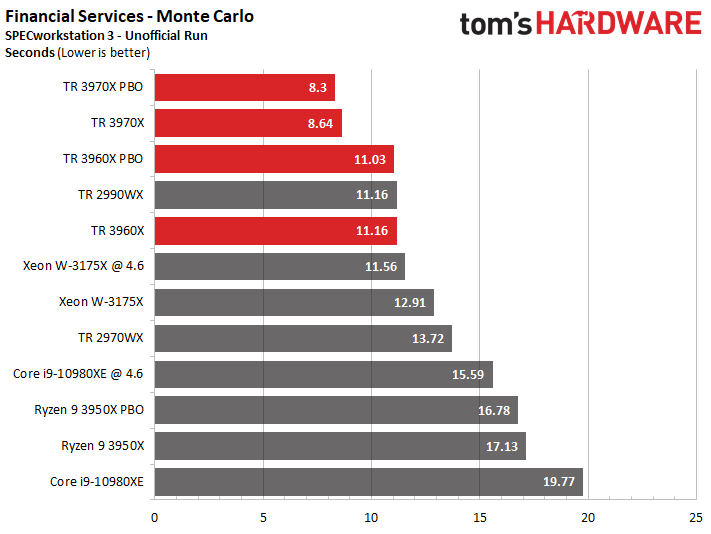
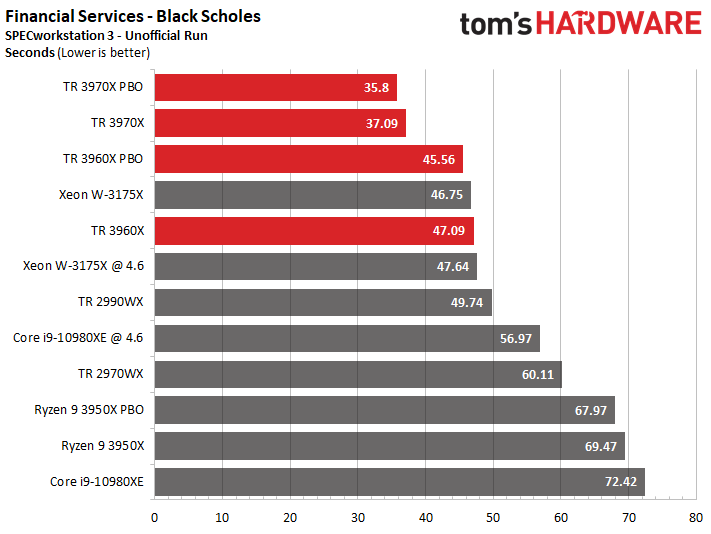
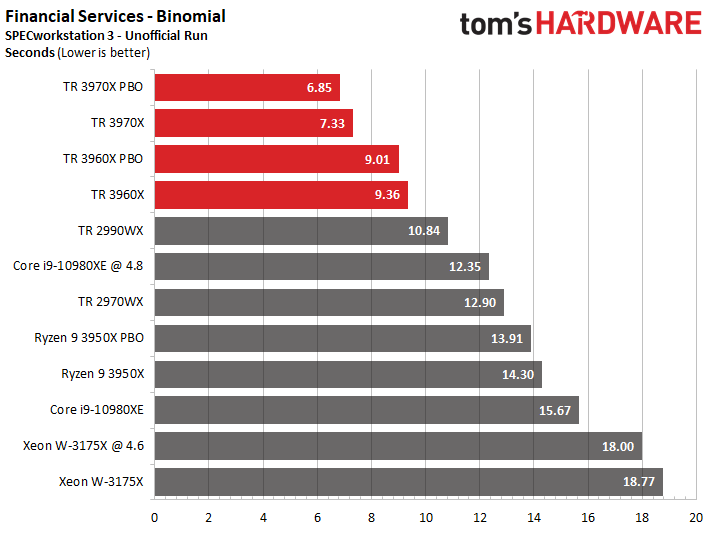
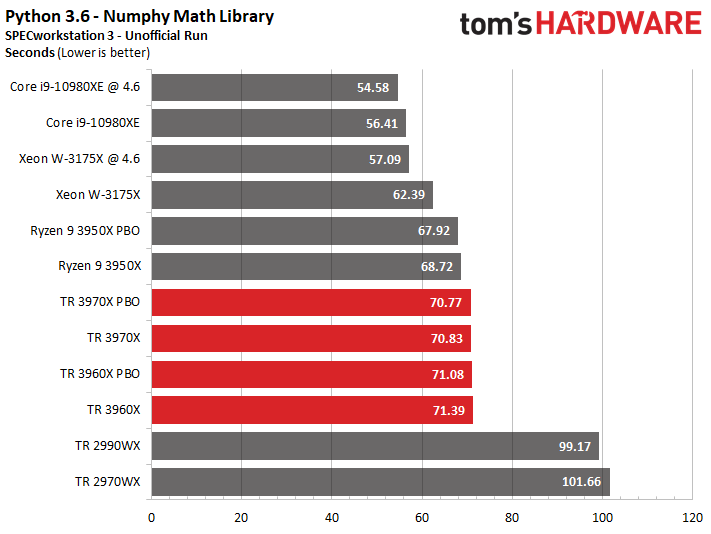
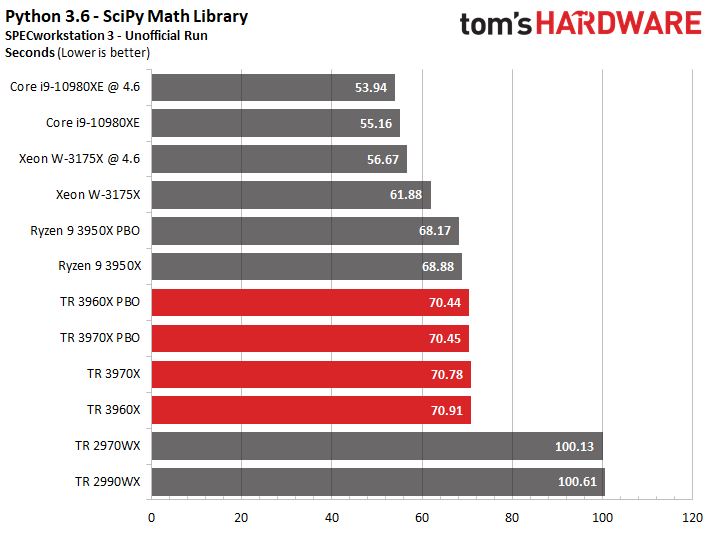
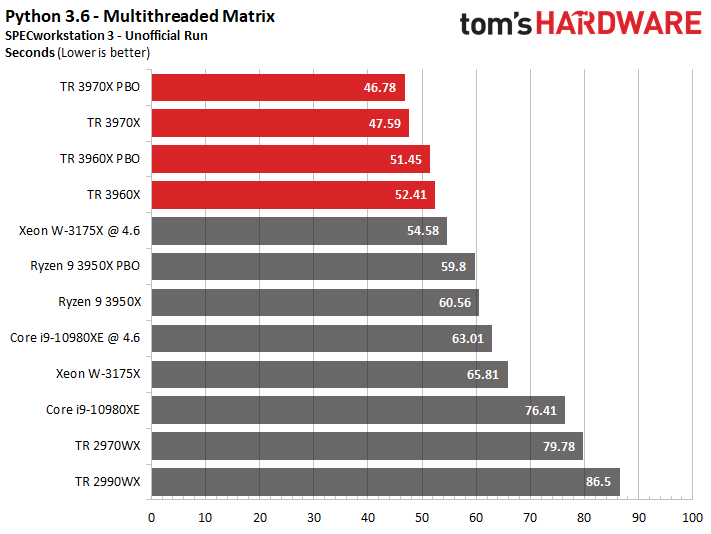
The Monte Carlo simulation is used to project risk and uncertainty in financial forecasting models. Here we see third-gen Threadripper post excellent performance metrics, with the previous-gen 32C/64T model matching the stock 24C/48T 3960X. Threadripper 3000 makes a clean sweep of the various financial models.
The Python benchmark conducts a series of math operations, including numpy and scipy math libraries, with Python 3.6. This test also includes multithreaded matrix tests that would obviously benefit from more cores, provided the software can utilize the host processing resources correctly. Naturally, the multithreaded matrix workload favors Threadripper 3000, but the Intel processors dominate the numpy and scipy tests.
MORE: Best CPUs
MORE: Intel & AMD Processor Hierarchy
MORE: All CPUs Content
Current page: Threadripper 3970X SPEC Workstation and Adobe Performance
Prev Page Threadripper 3970X Gaming Next Page Threadripper 3970X Application Performance
Paul Alcorn is the Editor-in-Chief for Tom's Hardware US. He also writes news and reviews on CPUs, storage, and enterprise hardware.
-
Vrooman By default, Numpy and Scipy in Python are compiled with Intel's MKL. This math library provides excellent results with Intel CPUs but quite poor results with AMD. Changing the compile flag to use OpenBlas math library provides significant speedups ( sometimes on the order of 100% ) with AMD processors in Numpy and Scipy. This has been reported fairly often in Puget Systems & Phonorix processor reviews and I've personally seen it in my 3900x use. Just a note I thought would be useful to point out ( as I'm not sure this is addressed in the review )Reply -
g-unit1111 Kind of unfair that the 3175X gets lumped in that category since it's nearly 3 times as expensive as the other CPUs included in the benchmark and has almost double the cores and threads. It's like comparing a Bentley Flying Spur to a Nissan Maxima.Reply -
delaro That is a massive amount of cores and threads that are twiddling their combined thumbs when your gaming. I'm surprised this review focused so much on that aspect. This isn't the kind of chip you buy for that use, this is the kind of chip you buy to make the games.:unsure:Reply -
AC5L4T3R 3950x currently on sale for 850 euros in Germany compared to 1550 for the 3960x. Really struggling to justify paying almost twice as much when theres nowhere near twice as much performance.Reply -
larkspur Reply
Huh? We're comparing high-end CPUs here. Most of the folks buying a threadripper are using it for professional purposes. Why wouldn't we include other high-end CPUs used for professional purposes? The 3175X isn't even the most expensive chip listed. The inclusion of a Ryzen 3950x is a nice comparison for those deciding whether the extra ~$1250 for the 3970x or ~$650 for the 3960x makes sense (not including platform costs). Just as the inclusion of the Intel 3175X helps to decide whether another ~$1000 makes sense to go with a somewhat comparable Intel. In the professional world these price differences aren't nearly as large as they seem. Time=money.g-unit1111 said:Kind of unfair that the 3175X gets lumped in that category since it's nearly 3 times as expensive as the other CPUs included in the benchmark and has almost double the cores and threads. It's like comparing a Bentley Flying Spur to a Nissan Maxima.
Still upset about abandoning TR4 but I know, I know. That's how it goes... <sigh> oh well :( -
RodroX Why not use a pci-e 4.0 nvme SSD for the tests?Reply
And why having to buy a new Mobo is a Con? Is the only way to support for PCI-E 4.0. This is not a consumer chip, so not having backward motherboard compatibility is not really an issue. -
larkspur Reply
Well, ultimately you're right, it's not a dealbreaker. It's just a PiTA - swapping a CPU is relatively quick. Swapping out an entire mobo + fresh OS and software install takes a lot more time. Like I said, you're right it's not a dealbreaker, but it would have been nice to get a Zen 2 chip in a TR4 mobo.RodroX said:And why having to buy a new Mobo is a Con? Is the only way to support for PCI-E 4.0. This is not a consumer chip, so not having backward motherboard compatibility is not really an issue. -
TJ Hooker Reply
For the same reason that it's nice that Ryzen 3000 chips work on pre-X570 motherboards: it's nice to have that option. The new chips are still attractive options even without PCIe 4.0.RodroX said:And why having to buy a new Mobo is a Con? Is the only way to support for PCI-E 4.0. -
RodroX ReplyTJ Hooker said:For the same reason that it's nice that Ryzen 3000 chips work on pre-X570 motherboards: it's nice to have that option. The new chips are still attractive options even without PCIe 4.0.
I know that, heck I have an R5 3600 runing on inexpensive B450 mobo. But if you swap pins around, and you don't have extra ones like it seems AMD had to accomodate the pci-4 support on AM4 socket for its consumer chips, then theres no much you can do right?
Its nice to have, but I still wont think is a Con.